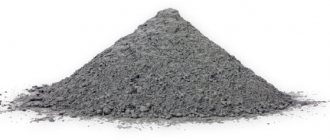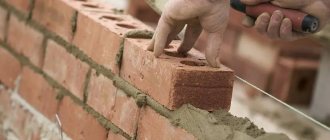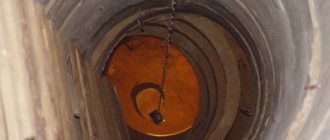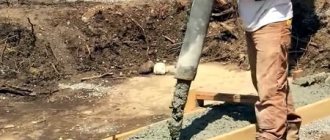During construction, it is important to correctly calculate the cement consumption per cubic meter of concrete. The building material is considered a key element of the solution and largely determines the quality of the finished building. If there is not enough of it, the concrete will quickly collapse, and if there is too much, it will become too hard and begin to crack. To prepare a truly high-quality concrete mixture, you must strictly observe the ratio of all ingredients. The calculation is made according to the required brand of concrete, its purpose and purpose of preparation.
What affects cement consumption?
The main requirement for the solution is to achieve a given strength after hardening. Based on this, you should select the exact ratio of ingredients, taking into account their performance indicators. To calculate how much cement is needed per 1 cubic meter of concrete, the following criteria are taken into account:
- solution mobility;
- brand of concrete, setting time;
- type and fractional composition of sand;
- the presence of impurities in the sand (their amount should be no more than 15%, otherwise the material must be washed or sifted);
- the presence of additives that improve the characteristics of the solution;
- parameters of crushed stone (degree of contamination, fraction).
When calculating how much cement is needed per cube of concrete, the brand of the main component of the solution must be taken into account. On average, it should be twice the brand of the finished mixture. For example, when mixing M200 concrete, it is better to use M400 cement.
Preparing the mixture
The intermediate layer should be no more than 3 cm thick; it is better to use expanded clay. For screed construction, the material consumption will be 1:2 (expanded clay and sand concrete). Expanded clay granules will ensure the light weight of the solution, such installation will be economical and at the same time the strength properties will not be reduced. When pouring the screed, reinforcement should be laid. This procedure will prevent cracks from occurring after the solution dries.
When the consumption rate of sand concrete is known, the next step is to make the correct batch. It is recommended to perform the work in the following sequence:
- a container of the required size is filled with warm water, approximately from +15 to +25 degrees. For one kg of sand concrete, water consumption is 180-230 ml;
- Dry composition is added to the water;
- The mixture should be thoroughly mixed until even the slightest clots disappear. As a result, the solution should be homogeneous.
This sand concrete mixture must be used within two hours. Performs work with M300 brand solution, recommended at temperatures from +5 to +35 degrees. It will take a day to dry completely, and you can only walk on the screed after 7 days. The formwork is dismantled on the second day. Sand concrete structures will acquire full strength characteristics in 28 days, just like conventional concrete structures.
Calculation features
To determine the exact consumption, you can use ready-made tables, reference books or a calculator. Sometimes a practical calculation method is used by performing a test batch. When determining the required amount of material, you must not forget about some points that have a direct impact on the calculation:
- Concrete solutions are used to solve various problems. With their help, foundations are laid, reinforced concrete slabs are made, and lightweight structures are strengthened. In each individual case, cement consumption per 1 m³ of concrete can vary significantly.
- During mixing, you can use all kinds of additives that increase the mobility of the solution, make it more moisture-resistant, and resistant to low temperatures.
- When mixing the mortar with cement of a grade lower than required by standards, its volume is increased by 15%. At the same time, the amount of sand increases by 10%.
- Cement is usually sold in 50 kg bags. Thanks to this, it is easier to estimate how much cement is needed per 1 cubic meter of concrete. But first you need to count the number of bags of material in one cubic meter of mixture.
We plaster with our own hands
Apply three layers of plaster.
After calculating the required amount of material and purchasing dry components, we begin to carry out the work.
Step-by-step instruction:
- We prepare the surface. We clean the wall from dust and flaking building materials. We remove rust and oil stains.
- We prime the surface in 2-3 layers, applying each subsequent layer after the previous one has dried.
- Apply the plaster in three layers. First of all, spray a medium-consistency solution onto the wall; this can be done with your hands, with a spatula, or with a ladle. Then we rub the composition over the surface with a rule or a grater: apply 4-5 mm thick to a concrete surface, up to 7 mm to a brick surface, and up to 10 mm to wood.
- The second layer is the main one. Mix the solution a little thicker than for spraying. Using a spatula or trowel, apply the composition to the wall and rub it over the surface, leveling it.
- Apply the last layer with a thickness of no more than 4 mm, and prepare a more liquid solution for it. Apply the coating to the moistened base layer. After setting, but before the surface dries, we grout. For more information about plastering work without beacons, see this video:
A type of wall plaster is beacon finishing, which allows you to create a perfectly flat surface.
The guides are installed strictly according to the level at a distance slightly less from each other than the width of the rule. Beacons can remain in the wall or be removable.
Rule from the bottom up
Stages of applying plaster to lighthouses:
- We fill the area between the beacons with a solution and level it using the rule. We fill all the voids and carefully level them.
- We cover and rub the surface well.
Be sure to study the calculations of plaster consumption before starting work.
Repair is not complete without leveling the walls and performing plastering work. The surface treated with a cement composition serves as a reliable basis for finishing.
In order not to make mistakes when purchasing materials for independent repairs or to control the builders, you need to know how much material is consumed. After studying this article, you can easily calculate these indicators.
M200
Concrete M200 is relevant when making screeds or constructing the foundation of a building. It is distinguished by excellent strength characteristics, immunity to frost and sudden temperature fluctuations. To find out how much cement per cubic meter of M200 concrete is needed for work, it is permissible to take different units of measurement, but kilograms are considered the most relevant. With this calculation, it is not difficult to find out the number of bags of cement by dividing the standard volumes of building materials by 50. If the ingredients are measured in buckets, it is more convenient to make calculations using volumetric parts.
| Ingredients | Kg (liters) | Parts |
| Cement | 265 | 1 |
| Crushed stone | 1050 | 2,8 |
| Water | 180 | 20% |
| Sand | 860 | 2,8 |
| Supplements | 4,8 | according to instructions |
DIY construction
Now we move on to laying the first block. It must be laid in the highest corner, after the wall has been marked using fishing line. Then, in each of the corners, you need to lay one block and stretch the rope between them. But now you can lay out the remaining elements of the future building. Using a cement-sand mixture, we lay them around the perimeter. But, naturally, where it is supposed to make an entrance/exit to the building, they do not need to be laid.
Laying should begin from the corners, only with bandaging, i.e. — with a shift of half a block. If you can’t move it halfway, keep in mind that the shift must be at least 80 mm. In essence, these are the same bricks, but only much larger. Not in terms of properties, of course, but in terms of the structure of the masonry. That’s why they are stacked according to the same algorithm.
Window openings, as a rule, have a height of 4–5 rows of gas-foam block masonry from the foundation. It is necessary to perform reinforcement under this opening, and the reinforcement should begin from the third or fourth row - it depends on which of the rows the window will be located from - from the fourth or from the fifth.
To properly perform reinforcement, you need to make two parallel furrows using a wall chaser. Although you can also use a grinder for these purposes. On each side, these grooves must extend beyond the width of the future window by at least 300 mm. Now, as you may have guessed, reinforcement is placed in these grooves and then fixed using cement-sand mortar. Next, we continue to build the wall in the same way as before the reinforcement procedure.
It is necessary to install special lintels over door and window openings using a reinforcing belt. This must be done to increase the reliability of the building. For these purposes, we will need gas blocks/foam blocks shaped like the Latin letter “U”.
This is how the process of building a house or building for household needs—a garage/greenhouse—goes. As you can see, for a person who has already dealt with repair and construction work, this task is not at all difficult. And if the blocks have handles (recesses) on the sides for more convenient transportation, this will significantly speed up the construction process. But the shapes of blocks are written in another article on our website.
M300
M300 is considered a common concrete, suitable for pouring foundations, making beams with reinforcement frames, fences, and stairs. When figuring out how much cement per 1 cubic meter of concrete of this grade should be used in construction, they are guided by the fact that the density of the building material varies in the range of about 1450 kg/m³.
To create the mixture, the most suitable cement is M400 or M500. When using the first brand, about 366 kg of building material will be required per cubic meter of prepared solution, the second - about 319 kg. If we recalculate these parameters for packaging, the volumes of building materials will be 5.88 and 4.26 bags, respectively. With proper calculation of how much cement is in a cube of concrete, it is possible to create a solution that has a strength of 28 to 32 MPa.
Cement costs for other brands can be clarified in the table. If you want to prepare a mixture that meets the specified characteristics, it is important to comply with the given parameters, taking into account the ratio of other elements of the solution.
| Concrete grade | Kg (liters) | |
| M500 | M400 | |
| 100 | 160 | 175 |
| 150 | 191 | 215 |
| 250 | 256 | 295 |
| 350 | 325 | 380 |
| 400 | 355 | 420 |
What solutions are used for brickwork
For bricklaying, the mortar can be prepared in different proportions, with the addition of various additives and mixture components
Before starting any work, it is important to decide on the type of masonry mortar
Cement mortar plays an important role in construction
In modern construction, the following mixtures are mainly used:
- regular “cold solution”. The composition contains cement, sand and water. The simplest, classic method of preparing a strong mixture is used everywhere today. After the cement mortar hardens, the wall acquires sufficient strength and load-bearing capacity. This solution can be prepared in different proportions, it all depends on the desired brand of the final mortar and the brand of dry cement. M400-500 cement is mainly used and it is prepared 1 to 4;
- cement and lime solution. Both Portland cement and lime are used. Thanks to the combination of the composition, it is possible to significantly save on cement, and the structure is durable and with a sufficient level of moisture resistance. If necessary, additional dry components are added to the composition to increase frost resistance, water resistance and viscosity;
- lime mixture. Quicklime is added to the mixture as a hardener instead of cement. The advantage of the solution is the high plasticity of the composition over a long time. The main drawback that prevents the active use of the mixture is that the material absorbs moisture, which makes the use of a number of insulation materials unavailable and leads to the risk of wall destruction in the long term.
It is important to study the technology for preparing the mixture before making a solution
Correct proportions
To calculate how much cement per 1 cubic meter of concrete is used during construction, you need to understand that the quantitative composition of the mixed material is influenced by the design strength of the concrete mixture, the type and characteristics of the filler. Of particular importance are the grades of cement and concrete that are used in compiling cost tables. In construction work, cement of the M400 and M500 grades is mainly used, and its ratio with other elements of the mixture is calculated in parts.
It should be borne in mind that when calculating the volume of the solution, the yield is less than the original amount of ingredients. This is due to the fact that the mixture becomes denser during the kneading process. The volume of water is selected directly during mixing. The reason for this is their dependence on the characteristics of the mixture and the moisture content of the sand. Usually they work with a ratio of 1 to 2, that is, for each portion of cement add half a portion of water.
If you correctly calculate how much cement is needed per 1 cubic meter of concrete, this will allow you to prepare a complete solution that will retain its operational and technical parameters for many years. It is important not to make a mistake here, because any miscalculations will certainly affect further construction work and the reliability of the finished building.
Author of the article
Does it make sense to use M500 for the foundation?
The brand is used for pouring the foundations of houses with 3 floors and above with embedded metal reinforcement. The cost of M500 cement is significantly higher than its less active analogues, so it is rarely used in low-rise construction.
To obtain concrete M300, prepared from grade M500, take a ratio of 1/2.4/4.3 (kg) - active substance, sand and gravel. Preparation of M400 requires proportions 1/1.6/3.2 (kg). Water is taken at 50% of the amount of cement, but this figure directly depends on the humidity of the fine filler.
If the construction site is located in an area with large temperature differences, high groundwater levels and an aggressive external environment, it is recommended to use the M500 grade with the addition of plasticizing and water-repellent additives to the composition.
Then the structure will be less vulnerable to negative factors and will last longer without damage.











